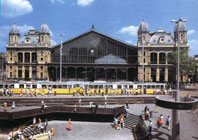In Hungary
Initiation and production of The De Valigia Train, sideline shows and catalogue in Hungary
by Stichting De Blinde Schilders.

with
converted Greek passenger carriage / (33 ) Greek artists
converted Danish passenger carriage / (26 ) Danish artists
converted Dutch cargo carriage / (28) Dutch artists
converted Yugoslavian passenger carriage / (33) Yugoslavian artists
converted Hungarian postal carriage / (28) Hungarian artists
one converted container on flat bed wagon as exhibition stage for artists from other countries
one 'look-in' container on a central position/square in every town
Time table
Budapest
Opening celebration in Budapest Nyugati (West) train station, Track 17, on the 2. October 1997, 7p.m.
Programme Opening celebration:
Opening speeches
officially opened by Minister of Transport, Communication and Water Management, Dr. Lotz Karoly
and General Manager of MAV, Istvan Sipos
Il teatro Artigiano de "La Scuola de Tovena"
exhibition dates: 3 Oct. till 23 Oct. 1997.
Szekesfehervar
Opening celebration 31 October, 8 p.m.
exhibition dates 1. Nov. until 11. Nov.
extended until 17. Nov.
Gyor
Opening celebration 26 November, 8 p.m.
exhibition dates 27 Nov. till 10 Dec.
opening times at all locations: 1 p.m. - 7 p.m.
* the project was on view to the public free of charge
Activities and sideline shows
Invites of Hungarian artist through collaborations with:
Bencsic Barnabás (Young Artist Association) Mentor
Bagyó Anna (independent)
Hegyi Dora (Ludwig Museum)
Kovalovsky Márta (City Museum Székesfehérvár)
Török Tamás (Budapest Gallery)
Preparation catalogue, De Valigia Train in Hungary, (1600 copies), which were sold for cost price to the public. Artist's addresses and telephone numbers have been published in the catalogue. preparation of Hungarian railway carriage.
Artist network party. 10 day prior to the opening, the artists, curators and organisers were getting together to party in a pre-arranged location.
65 suitcases from Italy, Germany and other countries, which were previously part of the De Valigia exhibition, were shown as satelite-exhibitions at:
1. Budapest Congress Centre
2. Container
The container was for the period of time, the show was in town in a very predominant place (City Hall, Museum, Shopping centre) in Budapest, Székesfehérvár and Györ city centres.
Educational activity
A mailing has been sent out to art teachers in schools to promote a visit for art teachers and their pupils to the train. Giving to the students an indication of what contemporary art can be about and for teachers to bring the project into the classroom. About 30 school classes attended the train.
Press conferences, publicity and media
Press conference in Budapest on the 2. October, 1.00 p.m. Nyugati Station, Queens room (Sissie's waiting room)
Preparation invitation cards and international mailing
Preparation posters and flyers
Newspapers and magazines: 40 publications
Television: 6 television documentaries
Visitor attendance
Visitors attendance at the opening in Budapest: about 650
Visitors attendance for the whole period of time in Hungary: about 8.000
Satelite-exhibition (Budapest Congress Centre) about 2.000
Container in city centres about 15.000
Official co-organiser and other co-operation
MAV (Hungarian Railways)
Budapest Autumn festival
Edina Kenesei, Ibolja Erdos
Jeroen van Roon
Budapest Gallery
Cultural Department of the City Council of Szekesfehervar
Cultural Department of the City Council of Gyor
Patron for DE VALIGIA TRAIN in Hungary
Attila Zsigmond General Director of Budapest Gallery and Deputy Minister of Culture
Participation of professionals (artists)
Adam Zoltan
Benczur Emese
Bukta Imre
Chesslay Gyorgy
Csorgo Attila
Eike
Farkas Gabor
Gerber Pal
Halasz Jozsef Karoly
Hegedüs 2 Laszla
Julius Gyula
Kaman Gyongyi
Komoroczky Tamas
Koronczi Endre
Kozari Hilda
Lengyel Andras
Lovas Ilona
Makovecz Anna
Dr. Marias Bela
Menesi Attila
Nagy Krisztna
Pal Csaba
Peto Hunor
Ravasz Andras
Swierkiewicz Robert
Szabics Agnes
Varnai Gyula
Várnagy Tibor
Oelveczky Gabor
Kelemen Benjamin Benoe
remarks
The project was getting much attention in the Art historian circle of Budapest and surrounding.
Since we were facing a big problem of the Austrian Railway company being not co- operative and giving us twice a 'no' in 1997. We had 2 choices either to extend the project in one more town in Hungary, to gain time for convincing the OeBB, or to stop the project. Through the positive co-operation of the MAV, we decided with real short time planning for a further stage Gyoer.
Through lobbying on very high levels and pushing to the extreme, we received a positive answer on the 23. December 1997, from the Director of the OeBB.
The Project can go on!
Thanks to the following people and instances
Jeroen van Roon, Nagy Mercedes, Boehler Nora, Szarvas Julia, Ivanyi Bianka, Toth Zsuzsa, Sipos Laszlo, Graf Zoltan, Feher Laszlo, Dijana Mc Carty, Szoegi Sandor, Toth Bela, Ferenc Kedves, Farkas Karoly, Lotz Karoly, Katalin Hegedues, Bencsik Barnabas, Kovalovszky Marta, Bagyo Anna, Willem v. Zanten for Wolters, Merey Zsolt, Czuczor Kinga, Kelenyi Attila, Hajdu Nora, Mate Peter, Maarten Wansdronk, Csaba Pal, Pinter Mariann, Budapest Galeria, János Szoboszlai, Imre Tolnay, Eva de Klerk, Dania ten Hoopen, Francesco Da Broi, Nicola Vanzan, Borg de Nobel, Mike, Nina v. Alphen, Rowin Snijder, Hans Gaasbeek, Hans Buitelaar, Judith Heumer, Tom-Andre Skullerud, Agnes Bompy, Rochier/Beeldspraak, Gianpaolo D'Andrea, Pietro Argenti, Loredana Manfre, Anita Possamai, Silverio Zanotto, The Ludwig Museum, Gabriella & Laszlo Kunos.
The Young Artist Association, for the use of their studio for photography of the artworks.